Kuppan T. Heat Exchanger Design Handbook
Подождите немного. Документ загружается.

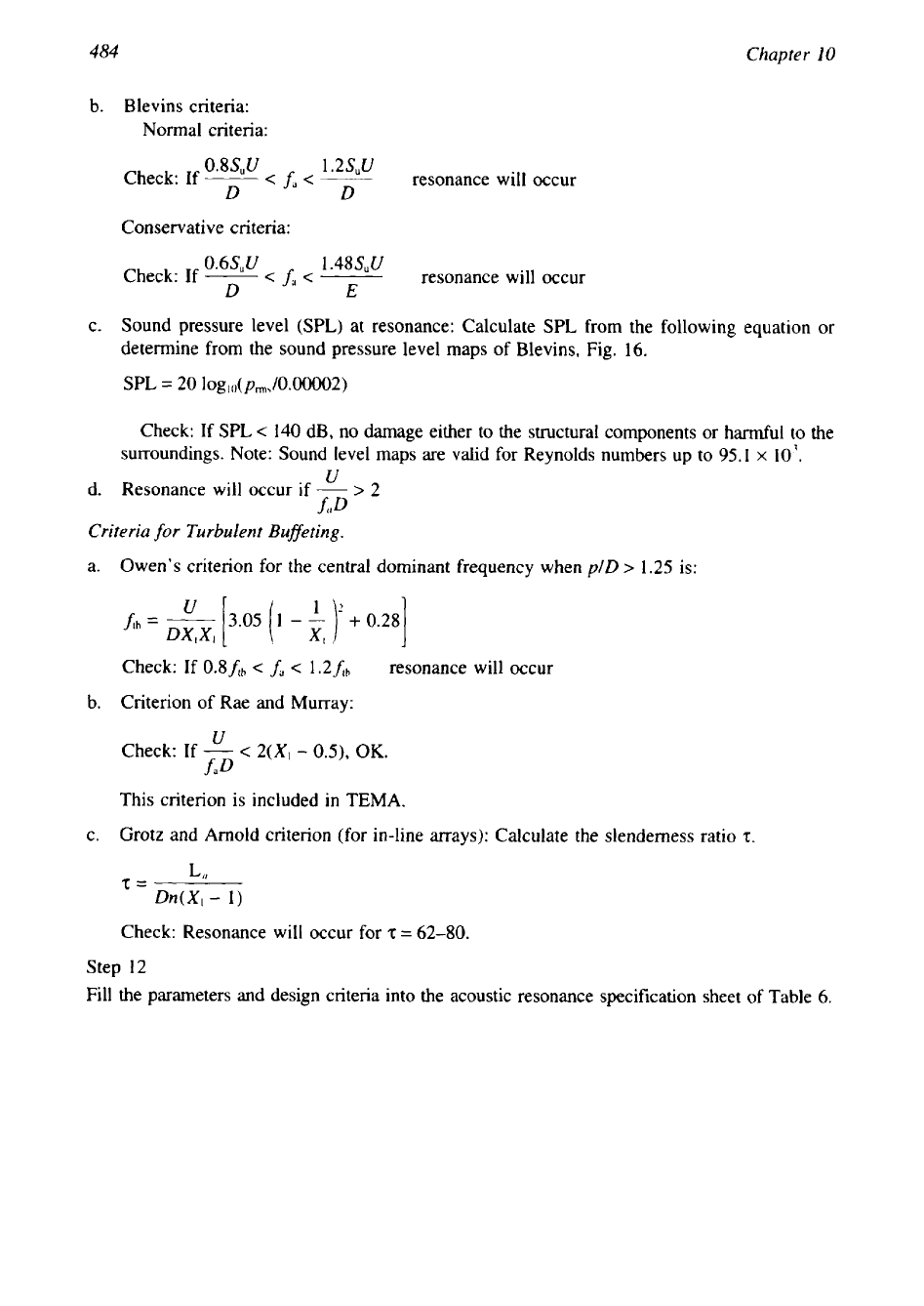
484
Chapter
10
b.
Blevins criteria:
Normal criteria:
0.8SuU
1
.2suu
Check: If
___
<fa<---
resonance will occur
D
D
Conservative criteria:
0.6SuU
1
.48SUU
I__
Check: If
<fd<----
resonance will occur
D
E
C.
Sound pressure level
(SPL)
at resonance: Calculate
SPL
from the following equation or
determine from the sound pressure level maps of Blevins, Fig.
16.
SPL
=
20
10g,,(p,,/0.00002)
Check: If
SPL
<
140 dB, no damage either
to
the structural components or harmful to the
surroundings. Note: Sound level maps are valid for Reynolds numbers up to
95.1
x
10’.
U
d. Resonance will occur if
-
>
2
LID
Criteria
for
Turbulent Buffeting.
a.
Owen’s criterion for the central dominant frequency when
plD
>
1.25
is:
Check: If
0.8fth
<
&
<
1.2f,b
resonance will occur
b.
Criterion of Rae and Murray:
U
Check: If
-
<
2(XI
-
0.5),
OK.
f3
This criterion is included in
TEMA.
c. Grotz and Arnold criterion (for in-line arrays): Calculate the slenderness ratio
7.
Check: Resonance will occur for
z
=
62-80.
Step
12
Fill the parameters and design criteria into the acoustic resonance specification sheet
of
Table
6.
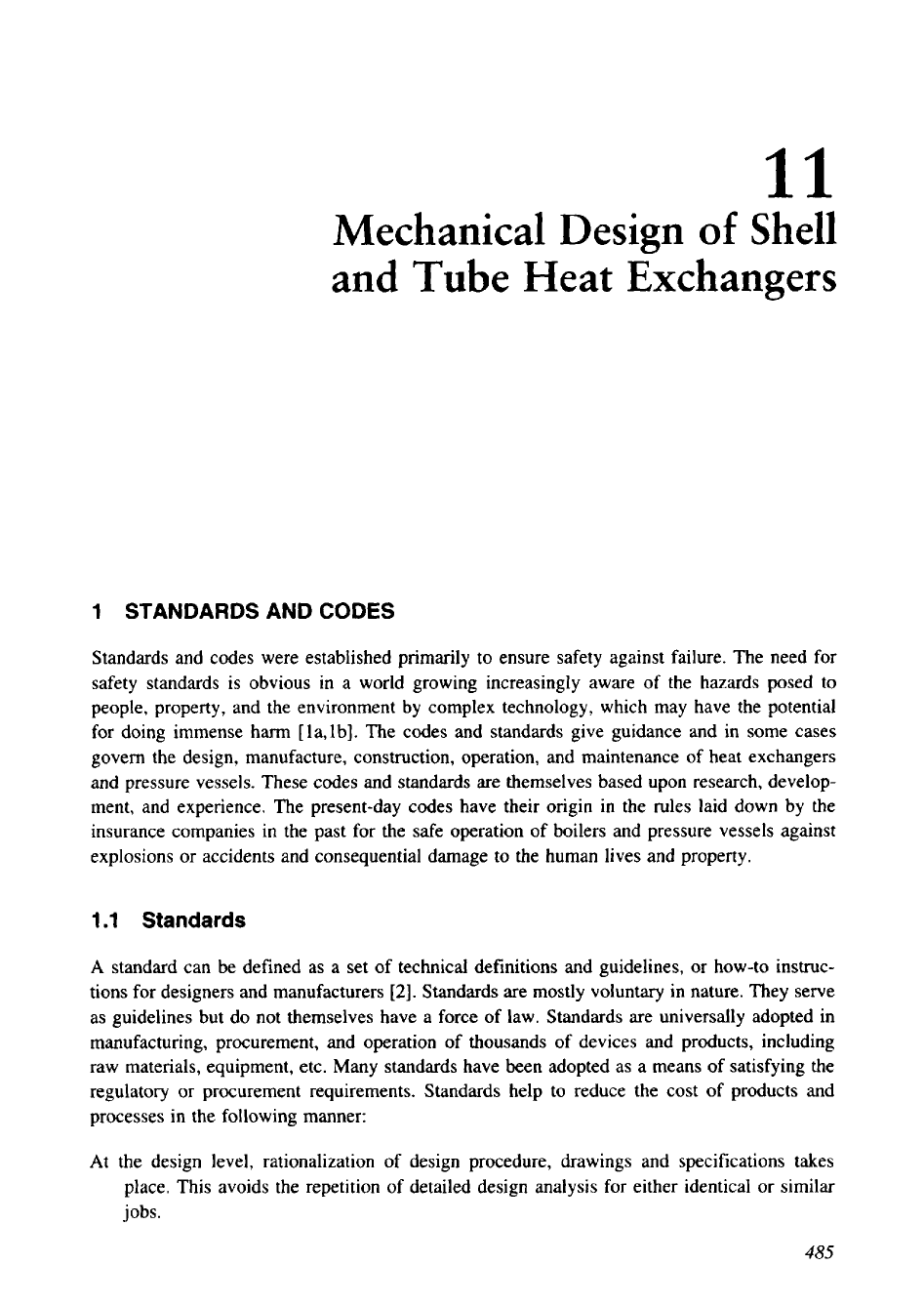
11
Mechanical Design
of
Shell
and Tube Heat Exchangers
1
STANDARDS AND
CODES
Standards and codes were established primarily to ensure safety against failure. The need for
safety standards is obvious in a world growing increasingly aware of the hazards posed to
people, property, and the environment by complex technology, which may have the potential
for doing immense harm [la,lb]. The codes and standards give guidance and in some cases
govern the design, manufacture, construction, operation, and maintenance of heat exchangers
and pressure vessels. These codes and standards are themselves based upon research, develop-
ment, and experience. The present-day codes have their origin in the rules laid down by the
insurance companies in the past for the safe operation of boilers and pressure vessels against
explosions or accidents and consequential damage to the human lives and property.
1.1
Standards
A
standard can be defined as a set
of
technical definitions and guidelines,
or
how-to instruc-
tions for designers and manufacturers
[2].
Standards are mostly voluntary in nature. They serve
as guidelines but do not themselves have a force of law. Standards are universally adopted in
manufacturing, procurement, and operation of thousands of devices and products, including
raw materials, equipment, etc. Many standards have been adopted as a means of satisfying the
regulatory or procurement requirements. Standards help to reduce the cost of products and
processes in the following manner:
At the design level, rationalization of design procedure, drawings and specifications takes
place. This avoids the repetition of detailed design analysis for either identical
or
similar
jobs.
485
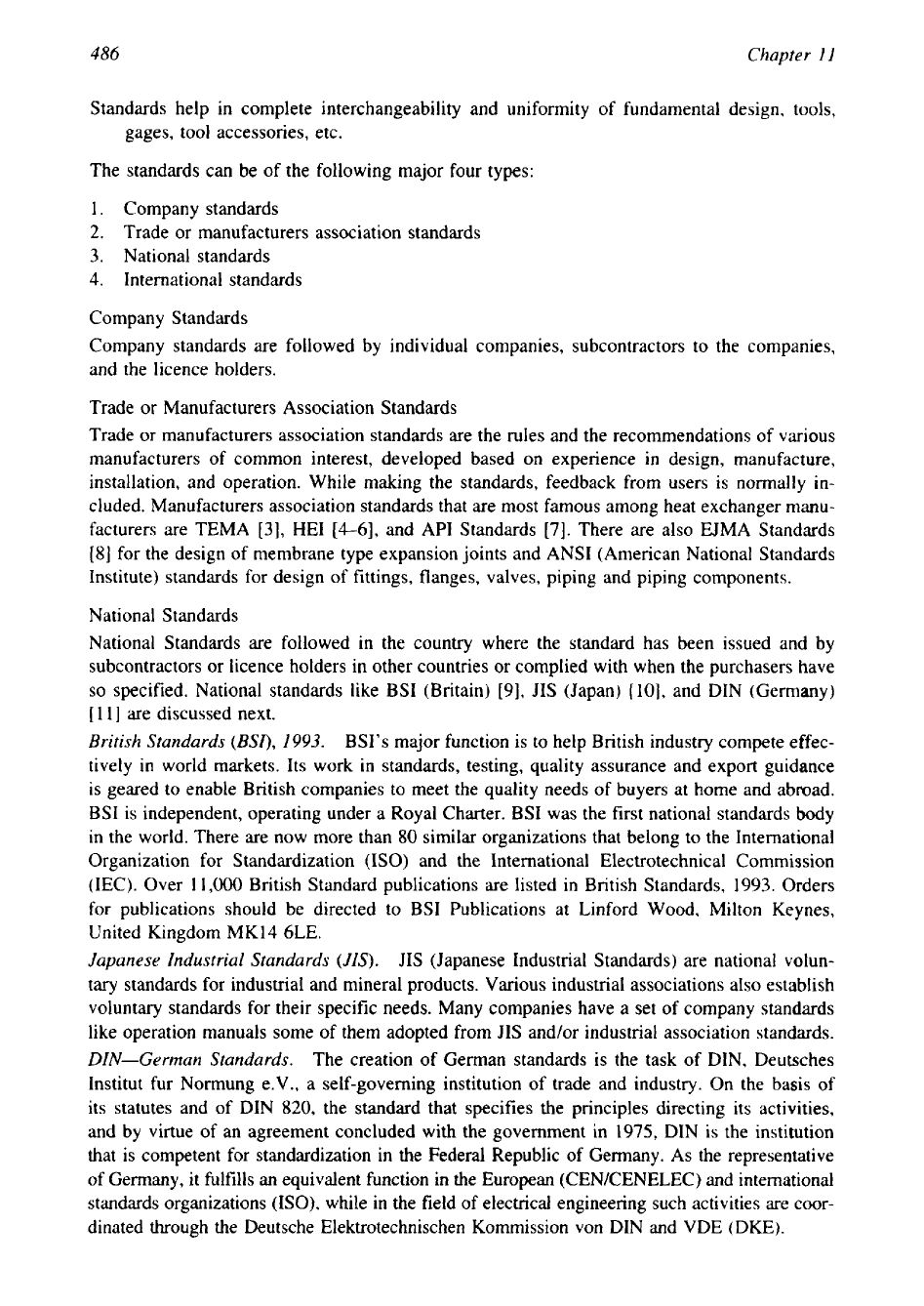
486
Chapter
I1
Standards help in complete interchangeability and uniformity of fundamental design, tools,
gages, tool accessories, etc.
The standards can be of the following major four types:
1.
Company standards
2.
Trade or manufacturers association standards
3.
National standards
4.
International standards
Company Standards
Company standards are followed by individual companies, subcontractors to the companies,
and the licence holders.
Trade or Manufacturers Association Standards
Trade or manufacturers association standards are the rules and the recommendations of various
manufacturers of common interest, developed based on experience in design, manufacture,
installation, and operation. While making the standards, feedback from users is normally in-
cluded. Manufacturers association standards that are most famous among heat exchanger manu-
facturers are TEMA
[3],
HE1 [4-61, and API Standards
[7].
There are also EJMA Standards
[8]
for the design of membrane type expansion joints and ANSI (American National Standards
Institute) standards for design of fittings, flanges, valves, piping and piping components.
National Standards
National Standards are followed in the country where the standard has been issued and by
subcontractors or licence holders in other countries
or
complied with when the purchasers have
so
specified. National standards like BSI (Britain) [9], JIS (Japan) [lO], and DIN (Germany)
[
111
are discussed next.
British Standards
(BSI),
1993.
BSI’s major function is to help British industry compete effec-
tively
in
world markets. Its work in standards, testing, quality assurance and export guidance
is geared to enable British companies to meet the quality needs of buyers at home and abroad.
BSI is independent, operating under a Royal Chatter. BSI was the first national standards body
in the world. There are now more than
80
similar organizations that belong to the International
Organization
for
Standardization (ISO) and the International Electrotechnical Commission
(IEC). Over
1
1,000
British Standard publications are listed
in
British Standards, 1993. Orders
for publications should be directed to BSI Publications at Linford Wood, Milton Keynes,
United Kingdom
MK14
6LE.
Japanese Industrial Standards
(JIS).
JIS (Japanese Industrial Standards) are national volun-
tary standards for industrial and mineral products. Various industrial associations also establish
voluntary standards for their specific needs. Many companies have a set of company standards
like operation manuals some of them adopted from JIS and/or industrial association standards.
DIN-German Standards.
The creation of German standards is the task of DIN, Deutsches
Institut fur Normung e.V., a self-governing institution of trade and industry. On the basis
of
its statutes and of DIN
820,
the standard that specifies the principles directing its activities,
and by virtue of an agreement concluded with the government in
1975,
DIN is the institution
that is competent for standardization in the Federal Republic of Germany. As the representative
of Germany, it fulfills an equivalent function in the European (CENKENELEC) and international
standards organizations
(ISO),
while in
the
field of electrical engineering such activities are coor-
dinated through the Deutsche Elektrotechnischen Kommission von DIN and
VDE
(DKE).
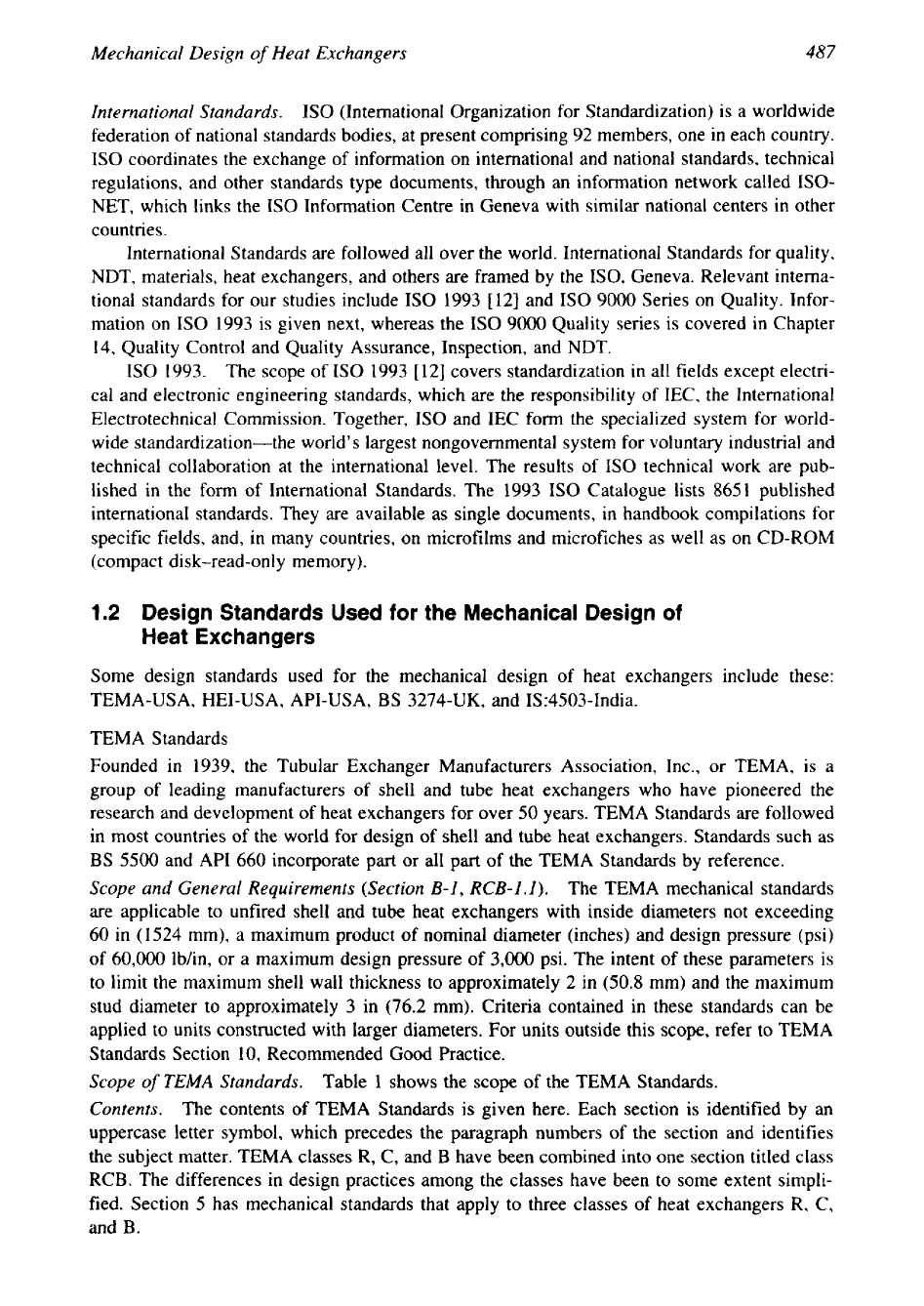
Mechanical Design
of
Heat Exchangers
487
International Standards.
IS0 (International Organization for Standardization) is a worldwide
federation of national standards bodies, at present comprising 92 members, one in each country.
IS0 coordinates the exchange of information on international and national standards, technical
regulations, and other standards type documents, through an information network called
ISO-
NET, which links the IS0 Information Centre in Geneva with similar national centers in other
countries.
International Standards are followed all over the world. International Standards for quality,
NDT, materials, heat exchangers, and others are framed by the ISO, Geneva. Relevant interna-
tional standards for our studies include
IS0
1993
[
121 and IS0 9000 Series on Quality. Infor-
mation
on
IS0 1993 is given next, whereas the
IS0
9000 Quality series is covered in Chapter
14, Quality Control and Quality Assurance, Inspection, and NDT.
IS0
1993. The scope
of IS0 1993 [12] covers standardization in all fields except electri-
cal and electronic engineering standards, which are the responsibility of IEC, the International
Electrotechnical Commission. Together, IS0 and IEC form the specialized system for world-
wide standardization-the world’s largest nongovernmental system for voluntary industrial and
technical collaboration at the international level. The results
of
IS0 technical work are pub-
lished in the form of International Standards. The 1993 IS0 Catalogue lists 8651 published
international standards. They are available as single documents, in handbook compilations for
specific fields, and, in many countries, on microfilms and microfiches as well as on CD-ROM
(compact disk-read-only memory).
1.2
Design Standards Used for the Mechanical Design
of
Heat Exchangers
Some design standards used for the mechanical design
of
heat exchangers include these:
TEMA-USA, HEI-USA, API-USA,
BS
3274-UK, and IS:4503-India.
TEMA Standards
Founded in 1939, the Tubular Exchanger Manufacturers Association, Inc., or TEMA, is a
group of leading manufacturers
of
shell and tube heat exchangers who have pioneered the
research and development of heat exchangers for over
50
years. TEMA Standards are followed
in most countries of the world for design of shell and tube heat exchangers. Standards such as
BS
5500
and API 660 incorporate part or all part
of
the TEMA Standards by reference.
Scope and General Requirements (Section
B-I, RCB-I
.I).
The TEMA mechanical standards
are applicable to unfired shell and tube heat exchangers with inside diameters not exceeding
60 in (1524 mm), a maximum product of nominal diameter (inches) and design pressure (psi)
of 60,000 lb/in, or a maximum design pressure
of
3,000
psi. The intent
of
these parameters is
to limit the maximum shell wall thickness to approximately
2
in
(50.8
mm) and the maximum
stud diameter to approximately 3 in (76.2 mm). Criteria contained in these standards can be
applied to units constructed with larger diameters. For units outside this scope, refer to TEMA
Standards Section 10, Recommended
Good
Practice.
Scope
of
TEMA
Standards.
Table 1 shows the scope of the TEMA Standards.
Contents.
The contents
of
TEMA Standards is given here. Each section is identified by
an
uppercase letter symbol, which precedes the paragraph numbers of the section and identifies
the subject matter. TEMA classes R, C, and B have been combined into one section titled class
RCB. The differences in design practices among the classes have been to some extent simpli-
fied. Section
5
has mechanical standards that apply to three classes of heat exchangers R,
C,
and
B.
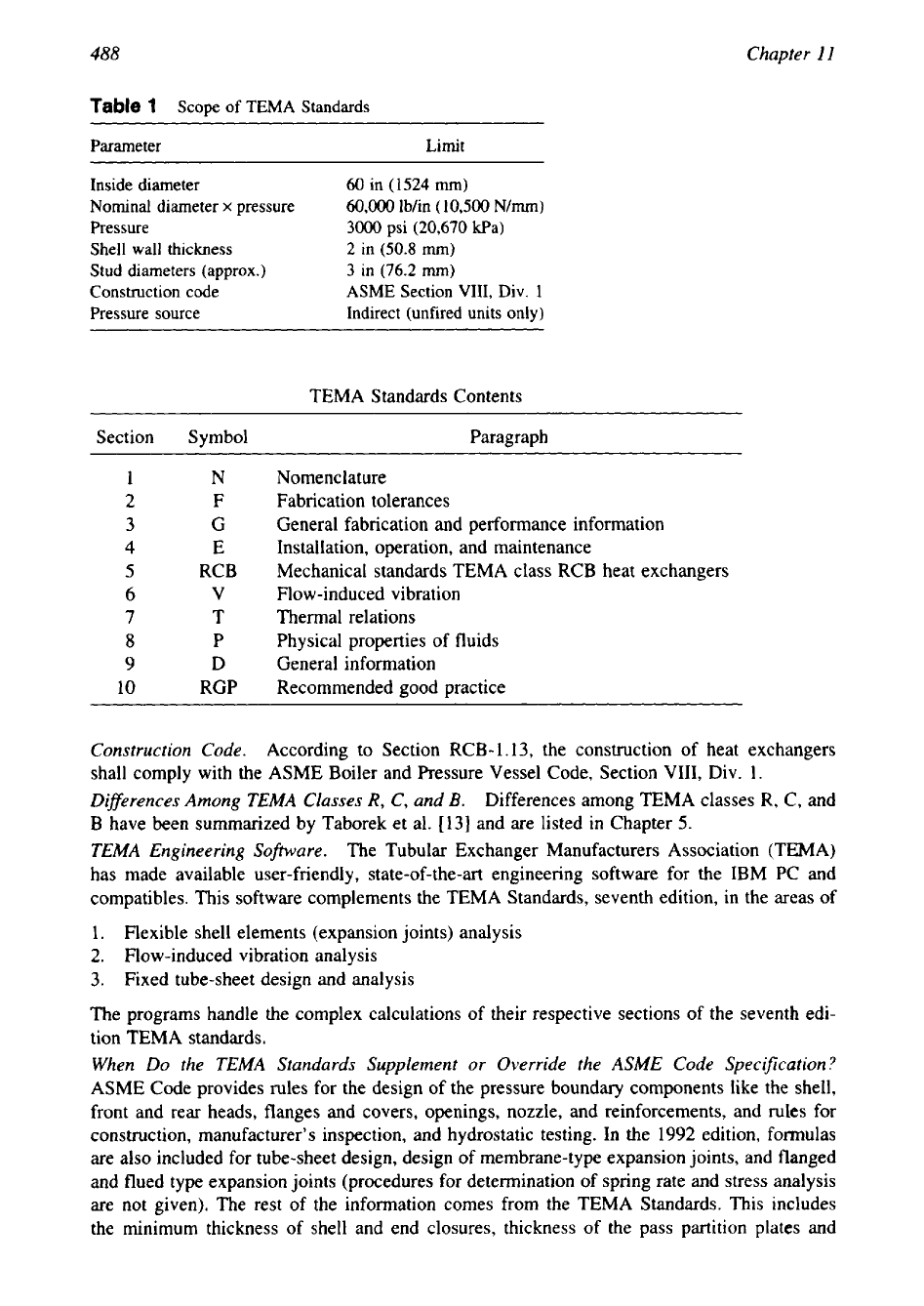
488
Chapter
1
I
Table
1
Scope
of
TEMA
Standards
Parameter Limit
Inside diameter
60
in (1524
mm)
Nominal diameter
x
pressure
60,OOO
lb/in (10,500
N/m)
Pressure
3000
psi (20,670 kPa)
Shell wall thickness
2
in
(50.8
mm)
Stud diameters (approx.)
3
in (76.2
mm)
Construction code
ASME
Section VIII, Div.
1
Pressure source
Indirect (unfired units only)
TEMA Standards Contents
Section Symbol Paragraph
~~~ ~
-
1
N
Nomenclature
2
F
Fabrication tolerances
3
G
General fabrication and performance information
4
E
Installation, operation, and maintenance
5
RCB
Mechanical standards TEMA class RCB heat exchangers
6
V Flow-induced vibration
7
T Thermal relations
8
P Physical properties
of fluids
9
D
General information
10 RGP
Recommended good practice
Construction Code.
According to Section RCB- 1.13, the construction of heat exchangers
shall comply with the ASME Boiler and Pressure Vessel Code, Section VIII, Div.
1.
Differences Among TEMA
Classes
R,
C,
and
B.
Differences among TEMA classes
R,
C, and
B have been summarized by Taborek et al. [13] and are listed in Chapter
5.
TEMA Engineering Sofrware.
The Tubular Exchanger Manufacturers Association (TEMA)
has made available user-friendly
,
state-of-the-art engineering software for the IBM PC and
compatibles. This software complements the TEMA Standards, seventh edition, in the areas
of
1. Flexible shell elements (expansion joints) analysis
2.
Flow-induced vibration analysis
3.
Fixed tube-sheet design and analysis
The programs handle the complex calculations of their respective sections
of
the seventh edi-
tion TEMA standards.
When
Do
the TEMA Standards Supplement
or
Override the
ASME
Code Specification?
ASME Code provides rules for the design of the pressure boundary components like the shell,
front and rear heads, flanges and covers, openings, nozzle, and reinforcements, and
rules
for
construction, manufacturer’s inspection, and hydrostatic testing. In the 1992 edition, formulas
are also included for tube-sheet design, design of membrane-type expansion joints, and flanged
and flued type expansion joints (procedures for determination
of
spring rate and stress analysis
are not given). The rest of the information comes from the TEMA Standards. This includes
the minimum thickness
of
shell and end closures, thickness of the pass partition plates and
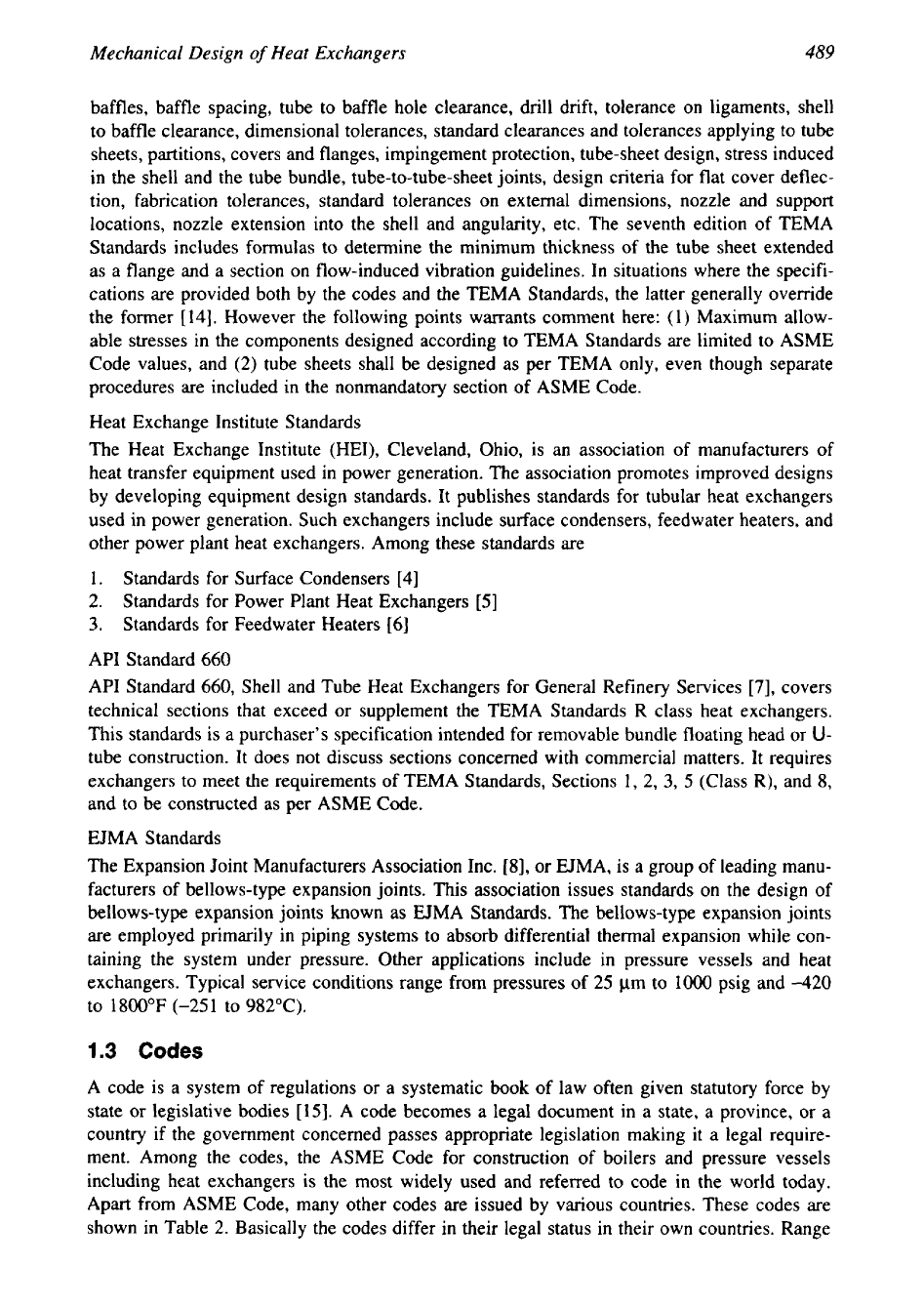
Mechanical Design
of
Heat Exchangers
489
baffles, baffle spacing, tube to baffle hole clearance, drill drift, tolerance on ligaments, shell
to baffle clearance, dimensional tolerances, standard clearances and tolerances applying to tube
sheets, partitions, covers and flanges, impingement protection, tube-sheet design, stress induced
in the shell and the tube bundle, tube-to-tube-sheet joints, design criteria for flat cover deflec-
tion, fabrication tolerances, standard tolerances on external dimensions, nozzle and support
locations, nozzle extension into the shell and angularity, etc. The seventh edition of TEMA
Standards includes formulas to determine the minimum thickness of the tube sheet extended
as a flange and a section on flow-induced vibration guidelines. In situations where the specifi-
cations are provided both by the codes and the TEMA Standards, the latter generally override
the former
[14].
However the following points warrants comment here: (1) Maximum allow-
able stresses in the components designed according to TEMA Standards are limited to ASME
Code values, and (2) tube sheets shall be designed as per TEMA only, even though separate
procedures are included in the nonmandatory section of ASME Code.
Heat Exchange Institute Standards
The Heat Exchange Institute (HEI), Cleveland, Ohio, is an association of manufacturers of
heat transfer equipment used in power generation. The association promotes improved designs
by developing equipment design standards. It publishes standards for tubular heat exchangers
used in power generation. Such exchangers include surface condensers, feedwater heaters, and
other power plant heat exchangers. Among these standards are
1.
Standards for Surface Condensers
[4]
2.
Standards for Power Plant Heat Exchangers
[5]
3.
Standards for Feedwater Heaters
[6]
API Standard
660
API Standard
660,
Shell and Tube Heat Exchangers for General Refinery Services
[7],
covers
technical sections that exceed or supplement the TEMA Standards R class heat exchangers.
This standards is a purchaser’s specification intended for removable bundle floating head or
U-
tube construction. It does not discuss sections concerned with commercial matters. It requires
exchangers to meet the requirements of TEMA Standards, Sections 1,
2,
3,
5
(Class
R),
and 8,
and to be constructed as per ASME Code.
EJMA Standards
The Expansion Joint Manufacturers Association Inc.
[S],
or EJMA, is a group of leading manu-
facturers of bellows-type expansion joints. This association issues standards on the design of
bellows-type expansion joints known as EJMA Standards. The bellows-type expansion joints
are employed primarily in piping systems to absorb differential thermal expansion while con-
taining the system under pressure. Other applications include in pressure vessels and heat
exchangers. Typical service conditions range from pressures of 25 pm to
1000
psig and -420
to 1800°F (-251 to 982°C).
1.3
Codes
A code is a system of regulations or a systematic book of law often given statutory force by
state or legislative bodies
[15].
A code becomes a legal document in a state, a province, or a
country if the government concerned passes appropriate legislation making it a legal require-
ment. Among the codes, the ASME Code for construction of boilers and pressure vessels
including heat exchangers is the most widely used and referred to code in the world today.
Apart from ASME Code, many other codes are issued by various countries. These codes are
shown in Table 2. Basically the codes differ in their legal status in their own countries. Range
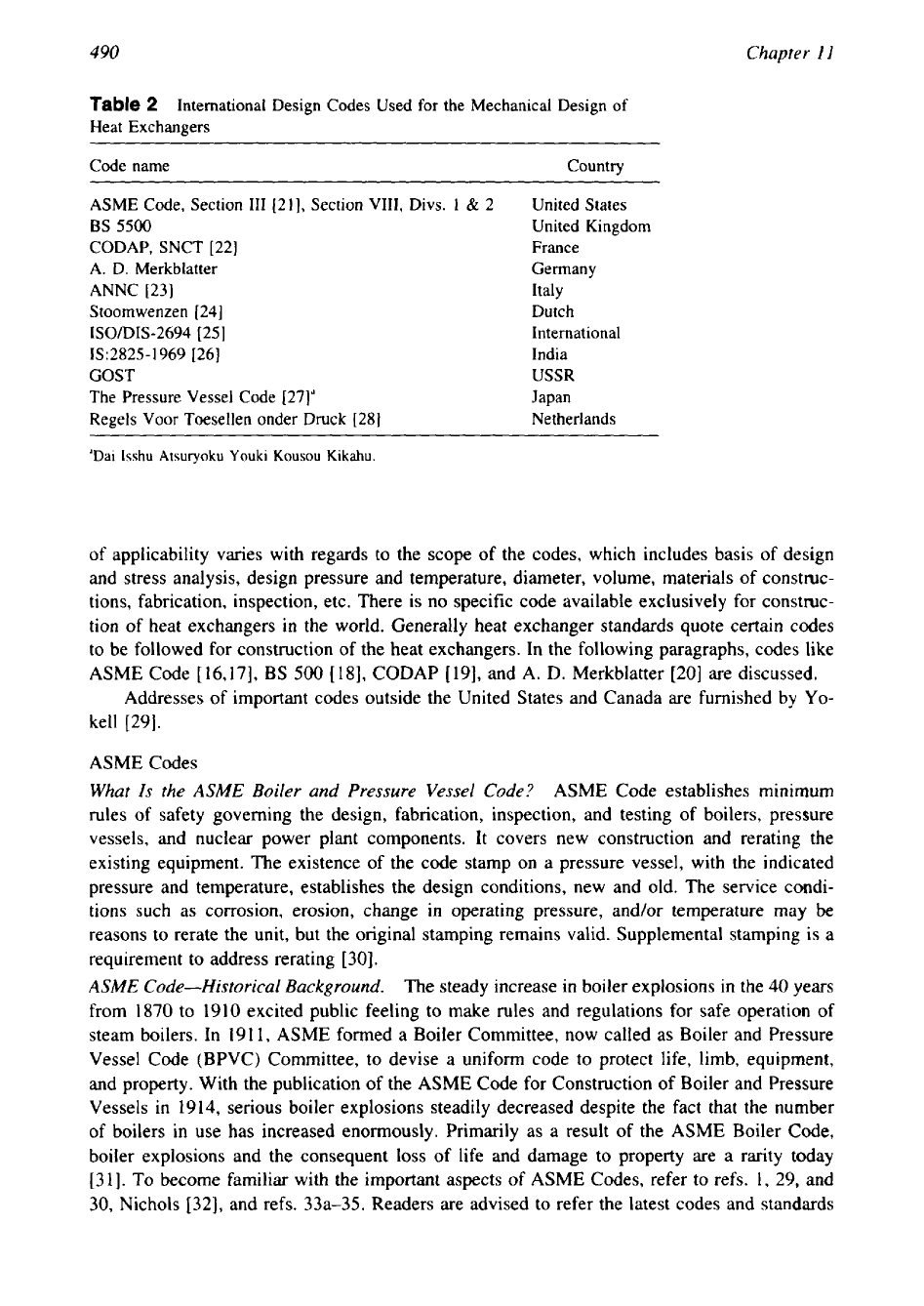
490
Chapter
1
I
Table
2
International Design Codes Used for the Mechanical Design
of
Heat Exchangers
Code name Country
ASME Code, Section
I11
[21], Section VIII, Divs.
1
&
2 United States
BS
5500
United Kingdom
CODAP, SNCT [22] France
A. D. Merkblatter Germany
ANNC [23] Italy
Stoomwenzen [24] Dutch
ISODIS-2694 [25] International
IS:2825-1969 [26] India
GOST USSR
The Pressure Vessel Code [27Id
Japan
Regels
Voor
Toesellen onder Druck [28]
Netherlands
'Dai
lsshu Atsuryoku Youki
Kousou
Kikahu.
of applicability varies with regards to the scope of the codes, which includes basis of design
and stress analysis, design pressure and temperature, diameter, volume, materials of construc-
tions, fabrication, inspection, etc. There is no specific code available exclusively for construc-
tion of heat exchangers
in
the world. Generally heat exchanger standards quote certain codes
to be followed for construction of the heat exchangers. In the following paragraphs, codes like
ASME Code
[
16,171,
BS
500
[
181, CODAP
[
191, and A. D. Merkblatter [20] are discussed.
Addresses of important codes outside the United States and Canada are furnished
by
Yo-
kell [29].
ASME Codes
What
Is
the
ASME
Boiler and Pressure Vessel Code?
ASME Code establishes minimum
rules of safety governing the design, fabrication, inspection, and testing of boilers, pressure
vessels, and nuclear power plant components. It covers new construction and rerating the
existing equipment. The existence of the code stamp on a pressure vessel, with the indicated
pressure and temperature, establishes the design conditions, new and old. The service condi-
tions such as corrosion, erosion, change in operating pressure, and/or temperature may be
reasons to rerate the unit, but the original stamping remains valid. Supplemental stamping is a
requirement to address rerating [30].
ASME
Code-Historical Background.
The steady increase in boiler explosions in the 40 years
from
1870
to 1910 excited public feeling to make rules and regulations for safe operation of
steam boilers. In 191 1, ASME formed a Boiler Committee, now called as Boiler and Pressure
Vessel Code (BPVC) Committee, to devise a uniform code to protect life, limb, equipment,
and property. With the publication of the ASME Code for Construction of Boiler and Pressure
Vessels in 1914, serious boiler explosions steadily decreased despite the fact that the number
of boilers in use has increased enormously. Primarily as a result of the ASME Boiler Code,
boiler explosions and the consequent loss of life and damage to property are a rarity today
[3
11.
To
become familiar with the important aspects of ASME Codes, refer to refs.
1,
29, and
30, Nichols [32], and refs. 33a-35. Readers are advised to refer the latest codes and standards
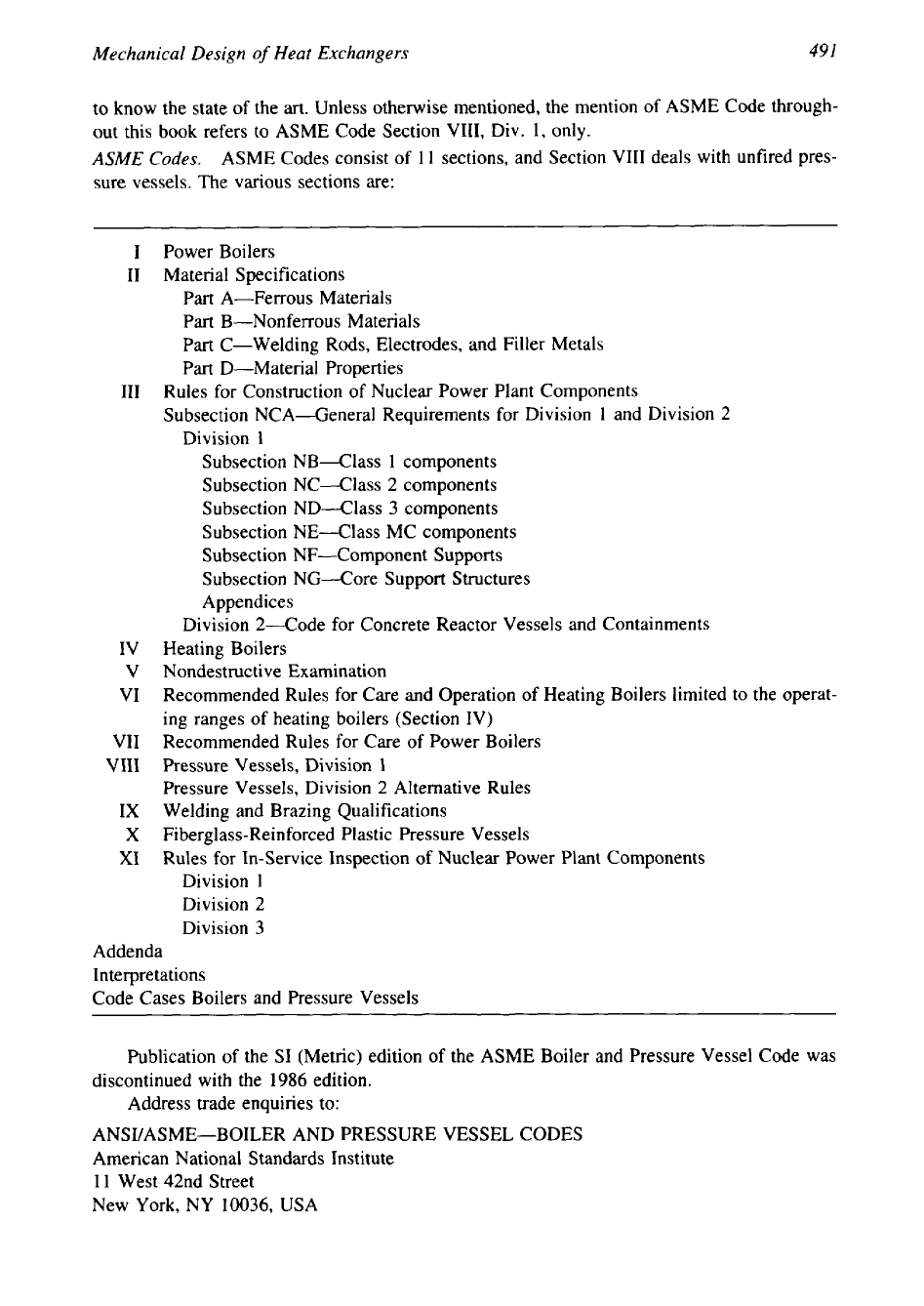
491
Mechanical Design
of
Heat Exchangers
to know the state of the
art.
Unless otherwise mentioned, the mention of ASME Code through-
out this book refers to ASME Code Section VIII, Div. 1, only.
ASME Codes.
ASME Codes consist of 11 sections, and Section VIII deals with unfired pres-
sure vessels. The various sections are:
I
Power Boilers
I1
Material Specifications
Part A-Ferrous Materials
Part B-Nonferrous Materials
Part C-Welding Rods, Electrodes, and Filler Metals
Part D-Material Properties
I11
Rules for Construction of Nuclear Power Plant Components
Subsection NCA-General Requirements for Division
1
and Division 2
Division 1
Subsection NB-Class 1 components
Subsection NC-Class 2 components
Subsection ND-Class
3
components
Subsection NE-Class MC components
Subsection NF-Component Supports
Subsection NG-Core Support Structures
Appendices
Division 2--Code for Concrete Reactor Vessels and Containments
IV
Heating Boilers
V
Nondestructive Examination
VI
Recommended Rules for Care and Operation of Heating Boilers limited to the operat-
ing ranges of heating boilers (Section IV)
VII
Recommended Rules for Care
of
Power Boilers
VIII
Pressure Vessels, Division
1
Pressure Vessels, Division
2
Alternative Rules
IX
Welding and Brazing Qualifications
X
Fiberglass-Reinforced Plastic Pressure Vessels
XI
Rules for In-service Inspection of Nuclear Power Plant Components
Division 1
Division
2
Division
3
Addenda
Interpretations
Code Cases Boilers and Pressure Vessels
Publication of the SI (Metric) edition of the ASME Boiler and Pressure Vessel Code was
discontinued with the
1986
edition.
Address trade enquiries to:
ANSVASME-BOILER AND PRESSURE VESSEL CODES
American National Standards Institute
11 West 42nd Street
New York, NY
10036,
USA
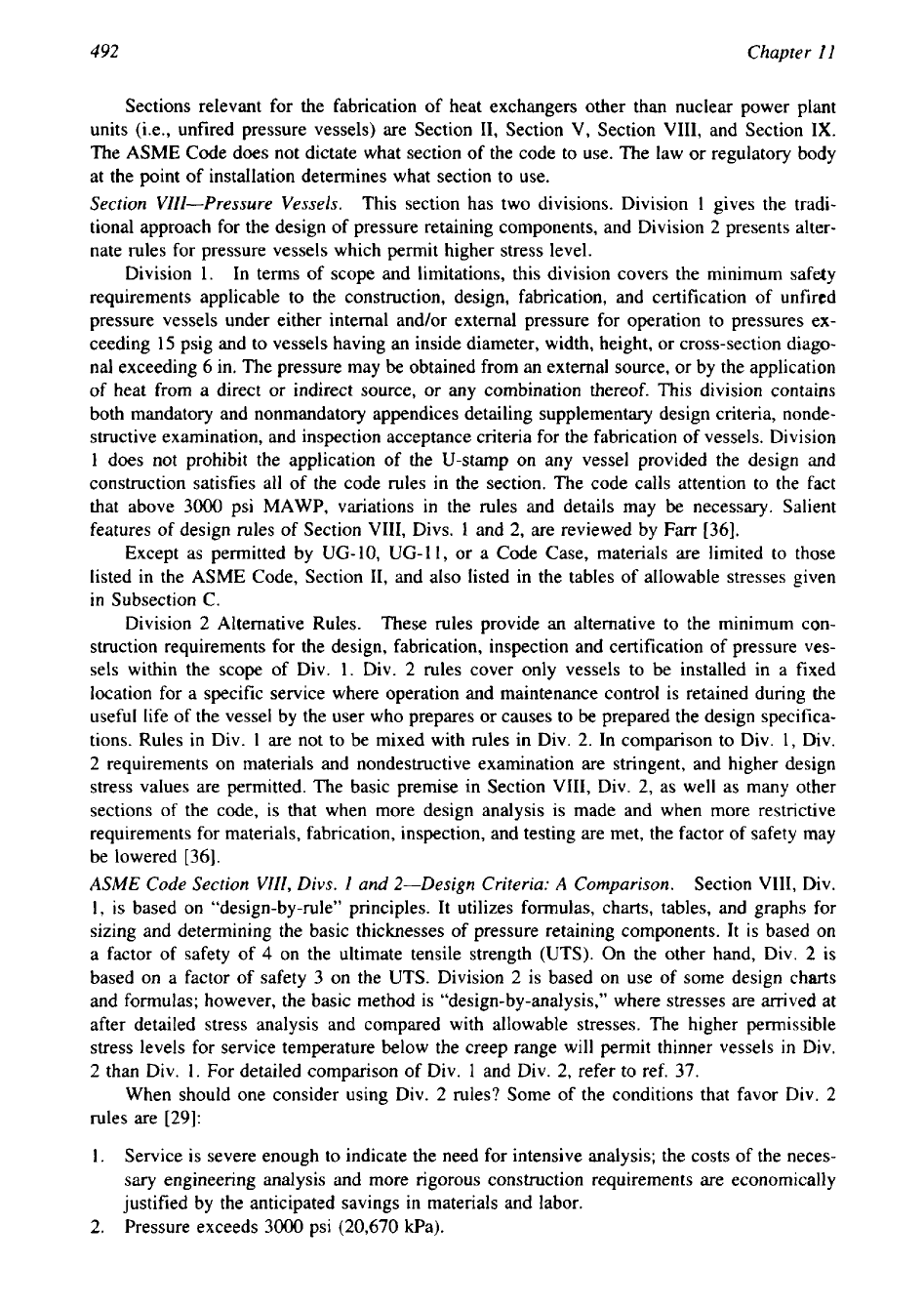
492 Chapter
11
Sections relevant for the fabrication of heat exchangers other than nuclear power plant
units (i.e., unfired pressure vessels) are Section
11,
Section V, Section VIII, and Section
IX.
The ASME Code does not dictate what section of the code to use. The law or regulatory body
at the point of installation determines what section to use.
Section VZZI-Pressure Vessels.
This section has two divisions. Division
1
gives the tradi-
tional approach for the design of pressure retaining components, and Division
2
presents alter-
nate rules for pressure vessels which permit higher stress level.
Division 1.
In terms of scope and limitations, this division covers the minimum safety
requirements applicable to the construction, design, fabrication, and certification of unfired
pressure vessels under either internal and/or external pressure for operation to pressures ex-
ceeding
15
psig and to vessels having an inside diameter, width, height, or cross-section diago-
nal exceeding
6
in. The pressure may be obtained from an external source, or by the application
of heat from a direct or indirect source, or any combination thereof. This division contains
both mandatory and nonmandatory appendices detailing supplementary design criteria, nonde-
structive examination, and inspection acceptance criteria for the fabrication of vessels. Division
1 does not prohibit the application of the U-stamp on any vessel provided the design and
construction satisfies all of the code rules in the section. The code calls attention to the fact
that above
3000
psi MAWP, variations in the rules and details may be necessary. Salient
features of design rules of Section VIII, Divs. 1 and
2,
are reviewed by
Farr
[36].
Except as permitted by UG-10, UG-11, or a Code Case, materials are limited to those
listed in the ASME Code, Section 11, and also listed in the tables
of
allowable stresses given
in Subsection
C.
Division
2
Alternative Rules. These rules provide an alternative to the minimum con-
struction requirements for the design, fabrication, inspection and certification of pressure ves-
sels within the scope of Div.
1.
Div.
2
rules cover only vessels to be installed in a fixed
location for a specific service where operation and maintenance control is retained during the
useful life of the vessel by the user who prepares or causes to be prepared the design specifica-
tions. Rules in Div.
1
are not to be mixed with rules in Div.
2.
In comparison to Div.
1,
Div.
2
requirements on materials and nondestructive examination are stringent, and higher design
stress values are permitted. The basic premise in Section VIII, Div.
2,
as well as many other
sections of the code, is that when more design analysis is made and when more restrictive
requirements for materials, fabrication, inspection, and testing are met, the factor of safety may
be lowered
[36].
ASME
Code Section VZZI,
Divs.
I
and 2-Design Criteria:
A
Comparison.
Section VIII, Div.
1,
is based on “design-by-rule” principles. It utilizes formulas, charts, tables, and graphs for
sizing and determining the basic thicknesses of pressure retaining components. It is based on
a factor of safety of
4
on the ultimate tensile strength (UTS). On the other hand, Div.
2
is
based on a factor of safety
3
on the UTS. Division
2
is based on use of some design charts
and formulas; however, the basic method is “design-by-analysis,” where stresses are arrived at
after detailed stress analysis and compared with allowable stresses. The higher permissible
stress levels for service temperature below the creep range will permit thinner vessels
in
Div.
2
than Div.
1.
For detailed comparison of Div.
1
and Div.
2,
refer to ref.
37.
When should one consider using Div.
2
rules? Some of the conditions that favor Div.
2
rules are
[29]:
1.
Service is severe enough to indicate the need for intensive analysis; the costs of the neces-
sary
engineering analysis and more rigorous construction requirements are economically
justified by the anticipated savings in materials and labor.
2.
Pressure exceeds
3000
psi
(20,670
kPa).
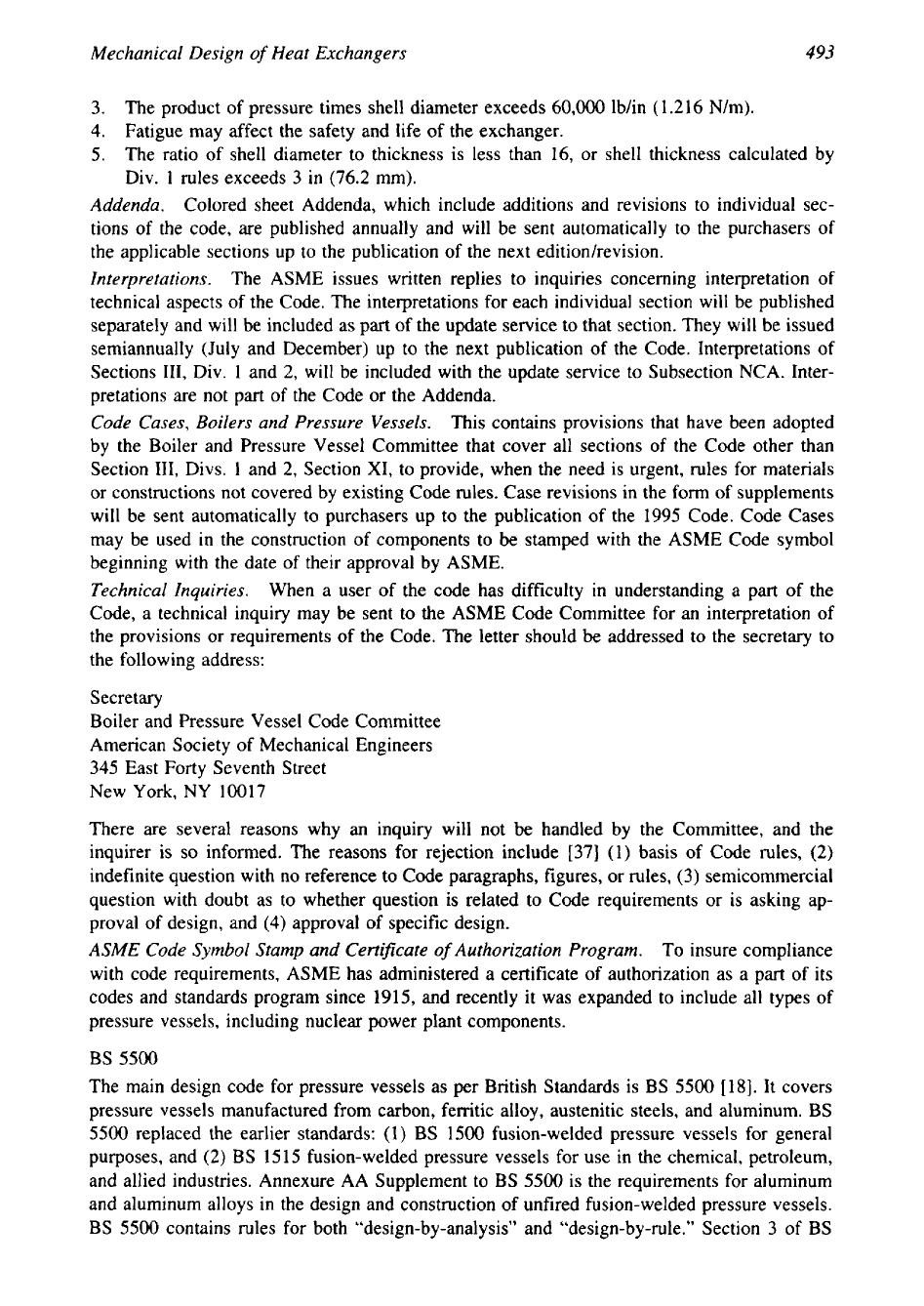
493
Mechanical Design
of
Heat Exchangers
3.
The product of pressure times shell diameter exceeds
60,000
lb/in
(1.216
N/m).
4. Fatigue may affect the safety and life of the exchanger.
5.
The ratio
of
shell diameter to thickness is less than
16,
or shell thickness calculated by
Div.
1
rules exceeds
3
in
(76.2
mm).
Addenda.
Colored sheet Addenda, which include additions and revisions to individual sec-
tions of the code, are published annually and will be sent automatically to the purchasers
of
the applicable sections up to the publication of the next edition/revision.
Interpretations.
The ASME issues written replies to inquiries concerning interpretation of
technical aspects of the Code. The interpretations for each individual section will be published
separately and will be included as part of the update service to that section. They will be issued
semiannually (July and December) up to the next publication of the Code. Interpretations of
Sections 111, Div.
1
and
2,
will be included with the update service to Subsection NCA. Inter-
pretations are not part of the Code or the Addenda.
Code Cases, Boilers and Pressure Vessels.
This contains provisions that have been adopted
by the Boiler and Pressure Vessel Committee that cover all sections of the Code other than
Section 111, Divs.
1
and
2,
Section XI, to provide, when the need is urgent, rules for materials
or constructions not covered by existing Code rules. Case revisions in the form of supplements
will be sent automatically to purchasers up to the publication of the
1995
Code. Code Cases
may be used in the construction of components to be stamped with the ASME Code symbol
beginning with the date of their approval by ASME.
Technical Inquiries.
When a user of the code has difficulty in understanding a part of the
Code, a technical inquiry may be sent to the ASME Code Committee for an interpretation of
the provisions or requirements of the Code. The letter should be addressed to the secretary to
the following address:
Secretary
Boiler and Pressure Vessel Code Committee
American Society of Mechanical Engineers
345 East
Forty
Seventh Street
New York, NY
10017
There are several reasons why an inquiry will not be handled by the Committee, and the
inquirer is
so
informed. The reasons for rejection include
[37]
(1)
basis of Code rules,
(2)
indefinite question with
no
reference to Code paragraphs, figures, or rules, (3) semicommercial
question with doubt as to whether question
is
related to Code requirements or is asking ap-
proval of design, and
(4)
approval of specific design.
ASME
Code Symbol Stamp and Certificate
of
Authorization Program.
To insure compliance
with code requirements, ASME has administered a certificate
of
authorization as a part of its
codes and standards program since
1915,
and recently it was expanded to include all types of
pressure vessels, including nuclear power plant components.
BS
5500
The main design code for pressure vessels as
per
British Standards is BS
5500
[
181.
It covers
pressure vessels manufactured from carbon, ferritic alloy, austenitic steels, and aluminum.
BS
5500
replaced the earlier standards:
(1)
BS
1500
fusion-welded pressure vessels for general
purposes, and
(2)
BS
1515
fusion-welded pressure vessels for use in the chemical, petroleum,
and allied industries. Annexure AA Supplement to
BS
5500
is the requirements for aluminum
and aluminum alloys in the design and construction of unfired fusion-welded pressure vessels.
BS
5500
contains rules for both “design-by-analysis” and “design-by-rule.” Section
3
of
BS
